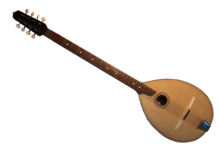Tambura
The tambura is a plucked long neck lute that is played as a folk musical instrument in Macedonia and in the southern part of Bulgaria . It is strung with four, six or eight, rarely two metal strings, which are always arranged in pairs. The tone of the tambura sounds metallic and is relatively short-lived. Similar long-necked sounds in the South Slavic language area are called tamburica .
Design
The tambura has a narrow, long neck with 18 to 20 frets that divide the octave into 12 semitones and a pegbox. The distance between the frets is reduced from the pegbox to the body of the instrument. The strings are made of metal. The melody is played on the first string.
The sound body of the tambura is rather flat (Bulgarian shape) to bulbous (Macedonian shape), oval and sometimes decorated with a wooden insert. The posture for playing the tambura corresponds to the posture for playing a guitar . However, the tambura is only more broadly related to the guitar. Depending on the tambura workshop, the tambura has a slightly different sound.
Style of play
The tambura is played with a pick , short notes are simply plucked from top to bottom, while long notes are played with tremolo , i.e. the respective note is repeated (sometimes as quickly as possible). There are two different playing techniques, the more modern technique is that only one pair of strings is fingered and plucked - this technique is often used when the tambura is played in an orchestra or larger ensemble. There is also an older (traditional) playing technique, in which only the lowest pair of strings is fingered, but plucked over two (or more rarely) pairs of strings of the tambura so that the strings that are not fingered play a drone tone (accompanying tone). This technique dates back to ancient times and is particularly common when the tambura is used as a solo instrument or to accompany a vocal part because it gives its sound more fullness.
In the past it was mainly men who played the tambura. Recently, however, women have also been good players on this instrument. The tambura occurs as a solo instrument, but it is often the accompaniment instrument for folk singers. Since it is a quiet instrument, it is seldom used to play in dance. The tambura has also found its place in the Bulgarian folk orchestra. A group of two or three high and low tamburas is formed. Usually eight-string tamburas are used, which are tuned as follows: e1, a, f, and c of the small octave. Its sound body has been enlarged for use in the orchestra, the fingerboard and the range expanded. This gives the tambura a strong tone. In the folk orchestra it is used both for accompaniment and as a solo instrument with very large technical possibilities.
distribution
The name of the South Slavic instrument is derived from Persian tanbūr and Arabic tunbūr . The namesake of the tambura is the tanpura played in India , which is also a long-necked lute, but differs significantly in design and sound, and the lyre tanbura , which is widespread around the Red Sea .
The closest relatives of the tambura outside the Balkan cultural area are the Italian mandolin and the Russian balalaika . In the Balkans , the tamburica , bouzouki and Šargija are related to the tambura, as is the baglama in Turkey . In the past, the tambura was exclusively an instrument to accompany singing, the combination of a singing voice and a tambura voice is probably the smallest possible Macedonian music ensemble, and yet very attractive. Even today it is still used to accompany vocals, but is also often played in ensembles with a wide variety of instruments, as it has a medium-sized range. In the Bulgarian Pirin Mountains , the combination of tambura and tarambuka ( darbuka ) is often common.
The tambura is less common than the shepherd's flute Kaval , the bagpipe Gaida or the string lute Gadulka . It is played mainly in the region of the Pirin Mountains, in the Rhodope Mountains, a little in central and western Bulgaria and in some areas of north-western Bulgaria.
The tambura is a main musical instrument in the Pirin and Rhodope regions. There she has taken on the role of the string instruments and is the most important instrument in the orchestra, while the others are of secondary importance.
Well-known tambura players
Macedonia:
- Dragan Dautovski
Bulgaria:
- Kiril Trajkov,
- Rumen Sirakov,
- Valeri Dimchev and his wife Desislava
literature
- Franz Jahnel: The guitar and its construction. Erwin Bochinsky, Frankfurt am Main 1963; 8th edition 2008, ISBN 978-3-923639-09-0 , pp. 15, 20 and 38 f.
Web links
- Sound sample Youtube
